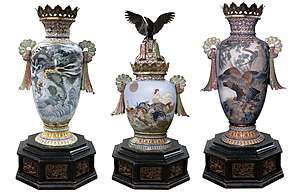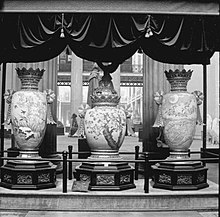Khalili Imperial Garniture
The Khalili Imperial Garniture is a trio of cloisonné vases created for a Japanese Imperial commission during the Meiji era.[1] The items were exhibited at the World's Columbian Exposition in Chicago, United States, in 1893, where they were described as "the largest examples of cloisonné enamel ever made".[2][3] After being exhibited, the vases were separated from each other for more than 120 years,[1] eventually reunited in 2019 in the private collection of the British-Iranian collector and scholar Nasser D. Khalili.[3]
| Khalili Imperial Garniture | |
|---|---|
 | |
| Artist | Shirozayemon Suzuki, Seizayemon Tsunekawa, Araki Kanpo |
| Year | 1893 |
| Medium | Cloisonné enamel on copper |
| Dimensions | 172 cm (68 in) |
| Owner | Nasser Khalili |
| Accession | E10, EX439, EX512[1] |
Creation and exhibition
During Japan's Meiji era (1868 to 1912), the government actively promoted Japanese arts and crafts abroad by exhibiting the best examples in the world's fairs that were held in America and Europe.[4] The first world's fair to exhibit Japanese art works in its Fine Arts section was the World's Columbian Exposition and among them was this garniture with a central incense burner.[2][5] It had been specially viewed by the Emperor who approved it for the exhibition.[6] The three vases are decorated with enamel and silver wire on a copper surface.[7] The eight feet, eight inches (264 cm) height quoted in the 1893 catalogue includes their pedestals[2] made of keyaki wood.[5] The height of the tall vases is 172 cm (five feet, eight inches).[2][7] The incense burner is topped by an eagle in bronze.[8]
A team of craftsmen, led by Shirozayemon Suzuki of Yokohama and Seizayemon Tsunekawa of Nagoya, took more than four years to construct the three items.[2] The painting was done by nihonga artist Araki Kanpo (1831–1915) who was a member of the Japanese Imperial Household's art committee and of the Royal Society of Arts, London,[2] later recognised in 1900 as an Imperial Household Artist.[9] Viewing the garniture in Tokyo before its shipping to Chicago, the Anglo-Irish scholar Francis Brinkley predicted that the Exposition would not display it in the Palace of Fine Arts because of its political symbolism. In fact it was displayed prominently in the East Court of the Palace as the ethnologist Hubert Howe Bancroft describes in his Book of the Fair.[10]
Decoration and symbolism

The idea for the design is credited to "Mr. Shin Shiwoda, Special Counsellor for the Arts of the Japanese Commission for the World's Columbian Exposition".[2] The three vases depict a dragon, chickens, and eagles, respectively representing the virtues of wisdom, honesty and strength.[2] The imagery also has a geographical connotation, with the dragon representing China, the eagles Russia, a rising sun for Japan, chickens for the Korean Islands and the bronze eagle on the central censer representing the United States.[2] The handles of the censer are shaped like chrysanthemums, the symbol of the Japanese Imperial family.[5] The general design also includes the four seasons of the year, with opposite sides of one vase showing autumn and winter scenes.[2] The eagle's appearance on a winter background, driving other birds before it, represents Russia's advance into East Asia.[5] The dragon representing China is depicted among summer clouds, heading towards autumn. The reverse of this vase depicts plover over waves. Japan's rising sun appears in a spring scene, suggesting "gladness and general revival".[5] The neck of each vase features a striped red and white pattern with inlaid silver stars.[2] The stars and stripes decorated with chrysanthemums and vines symbolise partnership between Japan and the United States.[5]
The Japan Weekly Mail of 15 April 1893 gave this interpretation of the design:
"Russia swooping down upon Korea finds her aggressive designs thwarted by China and Japan, while the Stars and Stripes wave their protecting folds over all; the American eagle spreads its wings above a scene where Korea, rescued and reviving on the threshold of spring, passes into the sunshine and bloom of Japan's early summer; the national flags of the United States and her Oriental friend intertwine everywhere overhead."[6]
The garniture was thus a political statement about how Japan saw its new status in the world, as a land of new beginnings that was emerging as the major regional power, allied with the United States against an encroaching Russia.[5] Events in the two decades after the World's Columbian Exposition unfolded similarly to what was depicted allegorically by the garniture. The First Sino-Japanese war ended with Japan defeating China and gaining control of the Korean peninsula, preventing Russia's advance into that territory. Japan's victory in the Russo-Japanese war made it the first Asian nation to defeat a Western power.[5]
Collection
Among the eight collections assembled, published, and exhibited by London-based collector, scholar and philanthropist Nasser Khalili is a collection of Japanese decorative art of the Meiji era, considered to be only equalled by the collection of the Japanese imperial family.[3] Khalili acquired the first vase, depicting eagles, in Los Angeles in the early 1990s.[1] It formed part of a 1999 exhibition of Meiji art in Wilmington, Delaware.[2] The incense burner depicting chickens was in the collection of the Tokyo National Museum until bought by Khalili in 2000.[1] The other vase, depicting a dragon, was considered lost to the antiques trade.[3] In January 2019, it was discovered; it had been the centerpiece of the main dining room of Spenger's Fresh Fish Grotto in Berkeley, California,[11] one of the oldest restaurants in the San Francisco Bay area.[12] Frank Spenger, son of the restaurant's founder, had acquired the vase at the 1894 California Midwinter Fair.[12] On 17 February 2019, Khalili bought it for $110,000 at an auction of Spenger family items, thus reuniting the garniture after more than 120 years.[3][12]
Gallery
References
- "News | The Khalili Collections Reunites Landmark Imperial Japanese Garniture – Said to be The Largest Examples of Cloisonné Enamel Ever Made – After Over 120 Years". Khalili Collections. 2019-04-12. Retrieved 2020-04-03.
- Earle, Joe (1999). Splendors of Meiji : treasures of imperial Japan : masterpieces from the Khalili Collection. St. Petersburg, Florida: Broughton International Inc. p. 234. ISBN 1-874780-13-7. OCLC 42476594.
- Arkell, Roland (1 March 2019). "Renowned collector Nasser Khalili revealed as buyer of 'lost' monumental Meiji vase as he reunites it with original set". Antiques Trade Gazette. ISSN 0306-1051. Retrieved 2020-04-03.
- Earle, Joe (1999). Splendors of Meiji : treasures of imperial Japan : masterpieces from the Khalili Collection. St. Petersburg, Fla.: Broughton International Inc. p. 10. ISBN 1874780137. OCLC 42476594.
- Snodgrass, Judith (2006). "Exhibiting Meiji Modernity: Japanese art at the Columbian Exposition". East Asian History. 31: 75–100. ISSN 1036-6008.
- Japan Weekly Mail, 15 April 1893, p.453, quoted in Snodgrass, Judith (2006). "Exhibiting Meiji Modernity: Japanese art at the Columbian Exposition". East Asian History. 31: 75–100. ISSN 1036-6008.
- "Japanese Art of the Meiji Period | Vase". Khalili Collections. Retrieved 2020-04-03.
- "Japanese Art of the Meiji Period | Incense Burner". Khalili Collections. Retrieved 2020-04-03.
- "Gazette" No. 5116, July 23, 1868.
- Earle, Joe (1999). Splendors of Meiji : treasures of imperial Japan : masterpieces from the Khalili Collection. St. Petersburg, Fla.: Broughton International Inc. p. 216. ISBN 1874780137. OCLC 42476594.
- Arkell, Roland (14 January 2019). "Monumental Meiji vase 'rediscovered' in a Californian restaurant comes to auction". Antiques Trade Gazette. ISSN 0306-1051. Retrieved 2020-04-03.
- Arkell, Roland (25 February 2019). "Huge 'lost' Meiji vase goes from seafood restaurant to saleroom". Antiques Trade Gazette. ISSN 0306-1051. Retrieved 2020-04-03.


